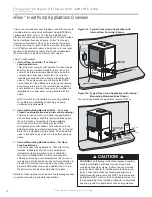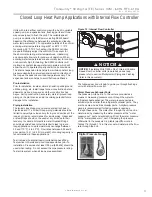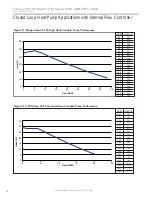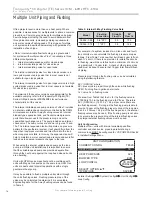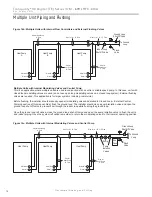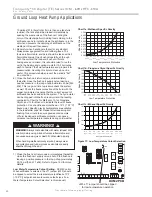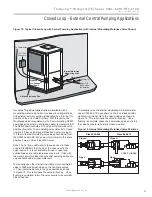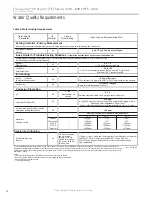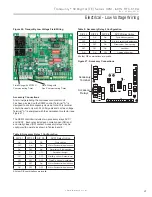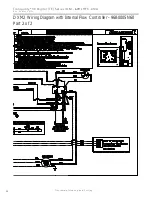
22
G e o t h e r m a l H e a t i n g a n d C o o l i n g
Tranquility
®
30 Digital (TE) Series IOM - 60Hz HFC-410A
R e v. : 2 9 M a y, 2 0 1 5 J
Internal Motorized
Modulating Valve
Water Out
Shut Off
Ball Valves
for Isolation
Water In
Pressure
Tank
Optional
Filter
Boiler
Drains
Open Loop or Ground-Water Heat Pump Applications
Figure 20: Typical Open Loop/Well Application
CAUTION!
CAUTION!
Refrigerant pressure activated water regulating
valves should never be used with this equipment.
Tranquility
®
packaged units are available with a water circuit
option for open loop applications (designated by a 6 in the
11th position of the unit model number).
The Motorized Modulating Valve is regulated by the
Communicating DXM2 board based on entering and leaving
water temperature (
Δ
T). The DXM2 board gives a 0-10v
signal to determine
fl
ow rate. The motorized modulating
valve defaults to closed position if it loses signal but still
has 24V power running to it. If the motorized modulating
valve loses both signal from the DXM2 board AND 24V
power, it will remain in the same position it was in when it
lost 24V power. DO NOT USE open loop units in closed loop
applications due to signi
fi
cant pressure drop through the
open loop motorized modulating valve. This option is only
available with Cupro-Nickel Water Coil.
To manually open the internal modulating motorized water
valve in TE026 – 049 push down on the handle to unlock
it. Then rotate the handle to the open position as shown
in Figure 19. This fully opens the valve for
fl
ushing. Once
fl
ushing is complete, return the valve handle to its normally
closed position.
To manually open the internal modulating motorized water
valve in TE064–072, push down on the lock release button
while turning the handle to the open position as shown in
Figure 19. This fully opens the valve for
fl
ushing. Once
fl
ushing is complete, press the lock release again and return
the valve handle to its normally closed position.
Open Loop - Ground Water Systems
Typical open loop piping is shown in Figure 20. Shut o
ff
valves
should be included for ease of servicing. Boiler drains or other
valves should be “tee’d” into the lines to allow acid
fl
ushing
of the heat exchanger. Shut o
ff
valves should be positioned
to allow
fl
ow through the coax via the boiler drains without
allowing
fl
ow into the piping system. Schrader ports built into
unit may be used to measure heat exchanger pressure drop.
Water temperature can be viewed on the communicating
thermostat. Supply and return water piping should be limited
to copper, HPDE, or other acceptable high temperature
material. Note that PVC or CPVC material is not recommended
as they are not compatible with the polyolester oil used in
HFC-410A products.
Water quantity should be plentiful and of good quality. Consult
Table 5 for water quality requirements.
vFlow
™
units for open
loop applications always come with Cupro-Nickel coils. In
ground water situations where scaling could be heavy or
where biological growth such as iron bacteria will be present,
an open loop system is not recommended. Heat exchanger
coils may over time lose heat exchange capabilities due to
build up of mineral deposits. Heat exchangers must only
be serviced by a quali
fi
ed technician, as acid and special
pumping equipment is required. Desuperheater coils can
likewise become scaled and possibly plugged. In areas with
extremely hard water, the owner should be informed that the
heat exchanger may require occasional acid
fl
ushing. In some
cases, the desuperheater option should not be recommended
due to hard water conditions and additional maintenance
required.
Water Quality Standards
Table 5 should be consulted for water quality requirements.
Scaling potential should be assessed using the pH/Calcium
hardness method. If the pH <7.5 and the Calcium hardness
is less than 100 ppm, scaling potential is low. If this method
yields numbers out of range of those listed, a monitoring plan
should be implemented in these probable scaling situations.
Other water quality issues such as iron fouling, corrosion
prevention and erosion and clogging should be referenced in
Table 5.



